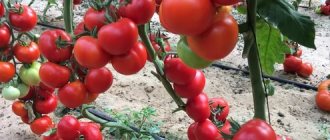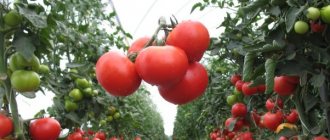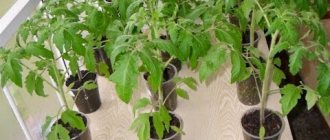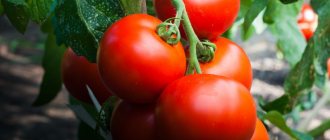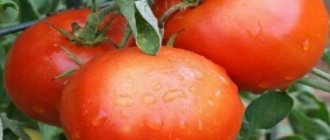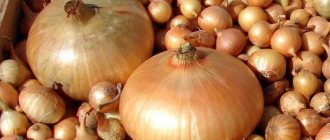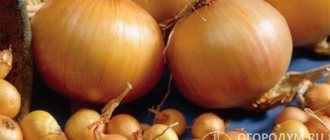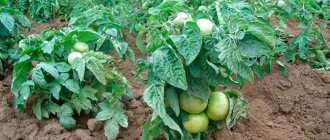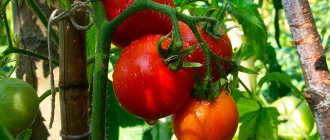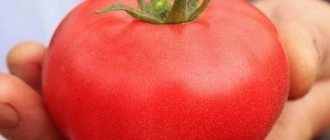Almost all gardeners grow tomatoes in open ground or in greenhouses. Breeders have developed an extremely large number of varieties and hybrids, starting with “classic” red tomatoes and ending with the most incredible shades and shapes of fruits. But not everyone can win the love of gardeners. Among the hybrids that enjoy steady popularity are Caspar F1. It is valued for its consistently good yield, rapid ripening of tomatoes and their universal purpose, long-term fruiting.
History of the variety's creation
The Caspar tomato was created in Holland in a well-known company called Royal Slus. This company is very popular due to the quality of its products. This variety was not included in the State Register, but even without this it is popular among vegetable growers.
The Caspar tomato variety can grow in different areas, both in the southern and northern regions. The only difference in cultivation is that in the southern regions the variety is grown in open ground, and in the northern regions it must be grown indoors.
Solving Common Problems
The bushes grow quite compact, so many vegetable growers forget about supporting structures and tying up plants. As a result, under the load of vegetables, the bushes bend to the ground, and the fruits begin to rot and deteriorate.
Often, beginning gardeners use nitrogen fertilizers as fertilizers, which is unacceptable after the ovaries have formed. Nitrogen primarily stimulates the growth of the green mass of plants, which leads to a sharp decrease in yield.
Tomato Caspar: characteristics and features of the variety
Tomato Caspar: photo of variety
- The bush has well-developed foliage. Therefore, when grown in the southern territory, it will provide the bush with protection from burns. It is worth noting that when growing the variety in the northern territory, the bush will need an additional light source, since the variety is light-loving.
- The Caspar tomato belongs to the Determinate species. Therefore, it has a fairly low bush, about 60 centimeters in height, and it is quite compact. If the variety is grown indoors, the height can reach up to 110 centimeters.
- Experts say that pinching is not necessary for the Caspar tomato variety if it grows in the southern territories. If the variety does not grow in the south, then pinching and formation are carried out, but thanks to this the fruits will ripen ahead of schedule.
- The tying of Caspar tomatoes must be carried out and this is a mandatory procedure. Since the variety is a high-yielding variety, branches without support will break under the weight of the fruit.
- The Kaspar tomato variety belongs to the average ripening period. Therefore, the first harvest can be harvested 90 days after the first shoots appear. In closed ground, the first harvest ripens within 80 days.
- The Kaspar tomato has a high yield. Despite its compactness, it can yield 2-3 kilograms from each bush.
- The fruits of this variety have a slightly elongated shape and also have a characteristic sharp end.
- Tomatoes have a bright red hue and can weigh up to 130 grams.
- The skin of the fruit is quite thick and durable, the flesh is sweet, but there is a slight sourness. The aroma of tomatoes is very pleasant. Due to the strong skin, the fruits never crack.
- In the cross section of the fruit you can see 1-3 chambers where the seeds are located; 3 chambers are very rare. Therefore, in general, the fruit consists only of dense and fleshy pulp.
- The Kaspar tomato variety is considered universal and can be used in cooking, especially in canning: preparing tomato paste, juice, pickled tomatoes. Since the skin is thick, it needs to be removed, and it comes off very easily even without using hot water.
- High resistance of Caspar tomatoes to diseases such as fusarium and verticillium.
Note: Tomato Kaspar f1 has a long shelf life. After harvesting, the fruits can be stored for about 50 days without changing their aroma, taste or appearance.
I would like to say that the Kaspar tomato, a few years after its creation, was slightly improved and became known as Hypil. This variety ripened early and changed its shape, which became similar to a pear. The rest of the qualities remained the same.
Russian breeders also slightly changed the Kaspar f1 variety. Breeder Anatoly Lukyanenko, together with the company, after research and experience, received a new hybrid, which was named Kaspar 2 tomato. This variety has already been included in the State Register.
Resistance to diseases and pests
During breeding, the variety was resistant to many common plant diseases of the nightshade family; therefore, they do not require special measures to combat and prevent them.
The plant is not affected by verticillium and fusarium, and is less resistant to late blight, but the variety is saved from massive damage and spread of the disease by its early ripening.
In addition, pests do not show much interest in tomato bushes of this variety. Exceptions include aphids.
Tomato Kaspar 2: variety description
Tomato Caspar: photo of variety
- Belongs to the determinant type.
- The bush reaches about 85 centimeters in height.
- The tomato variety Caspar 2 has an average ripening period, the first harvest is harvested after 95 days.
- This bush requires formation; the best choice would be formation into 2 stems.
- The fruits of the Kaspar 2 tomato are cylindrical in shape, each tomato weighs about 100 grams. Often used for pickles. It differs from Kaspar 1 in that it contains several times more sugar.
Let's talk about secrets.
Have you ever experienced joint pain? And you know firsthand what it is:
- inability to move comfortably and easily;
- pain during or after exercise;
- discomfort when going up and down stairs;
- inflammation in the joints, swelling;
- unpleasant crunching, clicking not of your own accord;
- causeless and unbearable aching pain in the joints.
Please answer the question: are you satisfied with this? Can such pain be tolerated? How much money have you already spent on ineffective treatment? It's time to end this! Do you agree? Today we are publishing an exclusive interview with Professor Dikul. in which the doctor revealed the secrets of getting rid of joint pain, treating arthritis and arthrosis.
Did you like the material? Be sure to save it to your social networks, or just print it:
Planting seedlings
The Caspar tomato variety is grown only from seedlings. Therefore, planting high-quality seedlings is important, as it guarantees that the bush will develop well and bring a large harvest. Sowing of seedlings begins in early spring, or rather in the second half of March.
Instructions for sowing seedlings.
- First you need to prepare the Caspar f1 tomato seeds, which will be planted in the ground. These seeds can be purchased in special stores. Such planting material will already be processed and disinfected.
- Seeds are planted dry without additional soaking.
- The soil for sowing is taken from the garden plot. Before use, you need to warm it up a little in the oven.
- Tomato seeds Caspar f1 are sown in furrows, covered with soil and sprayed with warm water. After which they are covered with film for 6 days.
- After the first shoots have appeared, certain criteria must be observed for the place where the seedlings will be stored. The temperature should be about +19 degrees at night and +23 degrees during the day. Good lighting is a must; if there is not enough light, you can use a fluorescent lamp. Watering should be done 1-2 times a week. And during the development of seedlings, 2 fertilizer applications should be made to the soil. Only mineral fertilizers should be applied and in small quantities.
- When two full leaves appear, the sprouts are transplanted into separate containers. Transplanting into separate containers stops the development of the sprout for 5-6 days. To prevent this from happening, the seeds can be sown individually at once.
- Before transplanting, about 15 days before, you need to start hardening the bush. To do this, the plant must be taken out into fresh air every day. The time spent in the fresh air increases daily, from 40 minutes to 24 hours.
Transfer
After the soil has warmed up and the temperature in it has become at least +17 degrees, you can replant the plant in open or closed ground.
The place where the plant will grow must be prepared in the autumn. The soil is fertilized by adding humus and fertilizers containing phosphorus. Nitrogen and potassium fertilizers are applied in the spring, 20 days before transplanting.
Note: Nitrogen and potassium fertilizers will wash into the lower layer of soil with water.
Planting of Kaspar f1 tomatoes is carried out according to a special scheme. There should be 70 centimeters between rows, and about 45 centimeters between bushes. Before transplanting, 30 grams of humus and 2-3 grams of any mineral fertilizer, as well as 20 grams of wood ash, are placed in each hole.
All ingredients of the mixture must be well mixed with the soil. Before planting, you need to thoroughly shed the soil. This will prevent injury to the tomato root system.
Note: If it happens that the Caspar f1 tomato seedlings become too large, you need to dig a ditch instead of a hole. Also, from such seedlings you need to remove 3 leaves at the bottom. And plant them to the north, guided by the top of the head. With such planting, additional roots appear in the tomato root system, which will further strengthen it in the soil.
After replanting, it is necessary to mulch using straw, hay or dried grass clippings. You also need to shade using arcs and placing, for example, Lutrasil on them. Lutrasil is a non-woven material; any other material will do instead.
The plant should be watered only 8 days after transplantation. If the weather is hot, watering is carried out after 5 days.
Transplanting to a garden bed
Caspar F1 tomatoes are transplanted into a greenhouse in early May, into open ground at the end of the month, when the weather stabilizes and the soil warms up to a temperature of 10-12 °C. By this time, the seedlings will get stronger, develop a good root system, form a sufficient number of leaves (5-6 pieces) and reach a height of 25-30 cm.
Before planting it in the garden, it needs to be accustomed to sunlight and outside temperature. 10 days before the planned transplant, the bushes are taken out into the fresh air in the first half of the day for 1-2 hours. Every day, the time spent in the fresh air is increased by 30 minutes, and on the last day the tomatoes are left overnight outside under film.
Preparing the site
The bed is prepared in the fall. Choose a place where cucumbers, legumes, onions, garlic, beets or cabbage previously grew. Clear the area of plant residues and weeds, apply organic and mineral fertilizers (per 1 m² 10 kg of compost or last year's manure, 3 kg of wood ash, 100 g of superphosphate, 80 g of potassium sulfate).
If necessary, add 350 g of chalk or slaked lime to acidic soil.
After this, deep digging is carried out.
In the spring, 2 weeks before planting, the bed is loosened and watered with urea solution (30 g of substance per 20 liters of water). This fertilizer increases soil fertility and destroys all pathogenic bacteria and microbes.
Tatyana Orlova (Vasilidchenko) (candidate of agricultural sciences):
In order to obtain the effect of soil disinfection from a urea solution, its concentration should be 3-5%. This is 300-500 g per 10 liters of water.
Planting scheme
The bushes are medium-sized, so seedlings are planted according to a 50x50 cm pattern. The optimal number of tomatoes per 1 m² is 5-6 pcs.
Dig holes according to the size of the root system, then water them with warm, settled water, lower the roots into the holes, cover them with earth and lightly compact them. For stability and protection from drying out, the stems are hilled.
Tomato variety Caspar f1: plant care
Tomato Caspar: photo of variety
- Caspar tomatoes need to be watered once every 7 days. But in dry and hot weather it doubles.
- Fertilizers must be applied once every 14 days. They must be mineral or complex. It depends on how fertile the soil is.
- Stepping is carried out as necessary. Everything below the first flower brush is removed. Pruning slightly reduces the yield level, but the fruits are larger.
- The lower leaves must be removed so that they do not interfere with the development of the fruit.
- If the Caspar tomato is grown in the southern region, where the sun shines every day, the leaves are not touched, as they protect the stem from burns.
- Prevention should be carried out using antifungal drugs.
If care is carried out completely and correctly, the plant will bring a large and tasty harvest.
Important nuances of agricultural technology
Caspar F1 tomatoes are extremely unpretentious in care and are able to “forgive” the gardener certain mistakes in care. They are grown mainly by seedlings. But obtaining a bountiful harvest is impossible without knowledge of the important nuances of agricultural technology.
Formation into two stems allows you to maintain the small dimensions of the Kaspar F1 bush without compromising productivity
Video: tips for growing Solanaceae seedlings
The “small size” of plants allows you to place 6–8 specimens per 1 m², thereby significantly saving space. The optimal planting pattern is 30–40 cm between bushes and about 50 cm between rows. But it requires the mandatory removal of stepsons so that the plants have enough space to develop.
The dimensions of the Caspar F1 tomato bushes allow them to be planted more compactly, saving space in the greenhouse or garden bed
The height of the bush is average, but the stem is not powerful enough to hold the entire mass of the crop. Therefore, plants often creep along the ground or even break. Fruits lying in the garden almost inevitably rot. To avoid this, the bushes must be tied to a support at the level of the 5th–6th leaf. The flowers of the hybrid begin to form after the 8th leaf; the procedure will not harm future fruits.
The small height of the Caspar F1 tomato does not require the construction of a trellis or other similar structure; you can get by with separate supports
The manufacturer claims that the plants do not need shaping, but this is not entirely true. In southern regions with a subtropical climate, Caspar F1 can indeed grow this way. Dense foliage is even beneficial; it protects the fruits from sunburn. In more severe conditions, it is recommended to remove excess leaves so as not to delay the ripening of fruits and the formation of plants into two stems. In addition to the main one, another stepson is left under the first fruit cluster.
Stepchildren on a tomato bush, if not removed, take away the nutrients necessary for fruit ripening
Video: different ways to form a tomato bush
Abundant and long-term fruiting requires enrichment of the soil with macro- and microelements necessary for the ripening of tomatoes. Caspar F1 is especially sensitive to a deficiency of potassium and phosphorus in the soil, so these fertilizers are applied to the hole when planting seedlings (about 10 g each).
Subsequently, during the growing season, 4 more feedings are carried out. The first time this is done when the first fruit ovary is formed, then every 2–2.5 weeks. The hybrid prefers mineral fertilizers without chlorine - potassium sulfate, potassium nitrate, simple or double superphosphate or complex products for tomatoes (Novofert, Master, Bona Forte, Agricola).
When preparing a nutrient solution for tomatoes, strictly follow the manufacturer's instructions; A common mistake made by novice gardeners is increasing the concentration of the product or reducing the intervals between fertilizing in hopes of an earlier and/or more abundant harvest.
Tomato Kaspar: reviews from gardeners who planted
Tomatoes Kaspar f1: photo of the variety
Anatoly Viktorovich, 59 years old, Perm: “I really liked the Kaspar tomato variety. I found only positive qualities. Caspar f1 tomatoes have a high yield level, the fruits are large and do not have tubercles on the skin. What is important for me (I took Kaspar tomatoes to my sister on the other side of the country) is that this variety is perfectly transported over long distances and has a long shelf life. I advise everyone to grow the Kaspar tomato variety!”
Marina Igorevna, 65 years old, Yekaterinburg: “I was pleased with the high resistance to pests and diseases in the Kaspar f1 tomato variety. The tomatoes grew tasty and large. What surprised me was that, despite the changeable weather in the summer, the Caspar f1 tomato adapts perfectly to the environmental conditions in which it is grown. The whole family appreciated the pleasant taste of the tomato variety.”
Advantages of hybrids
- High and stable yields, independent of weather conditions.
- Fruit evenness.
- Good transportability and long-term storage.
- Disease resistance.
- High plasticity, they adapt to any growing conditions.
Breeders, when creating a new hybrid, know well what properties it will have. For this purpose, parents with certain characteristics are selected. Hybrids are often created that are focused on the specific use of fruits: for industrial sales, for the manufacture of tomato products or whole-fruit canning.
The hybrid Caspar F1 belongs to the latter category, the description and characteristics of which will be presented below. Reviews from those who planted it are positive, and the photo shows fruits of excellent quality.
Errors during cultivation
The most common mistakes when growing this crop include:
- sowing low-quality (expired or diseased) seeds;
- using heavy, acidic, contaminated or poor soil for sowing;
- non-compliance with the rules for caring for crops - keeping them in darkness, cold and dry soil;
- lack of hardening before planting;
- violation of the watering regime, non-compliance with the diet and dosage, lack of loosening, weeding and preventive treatments.
